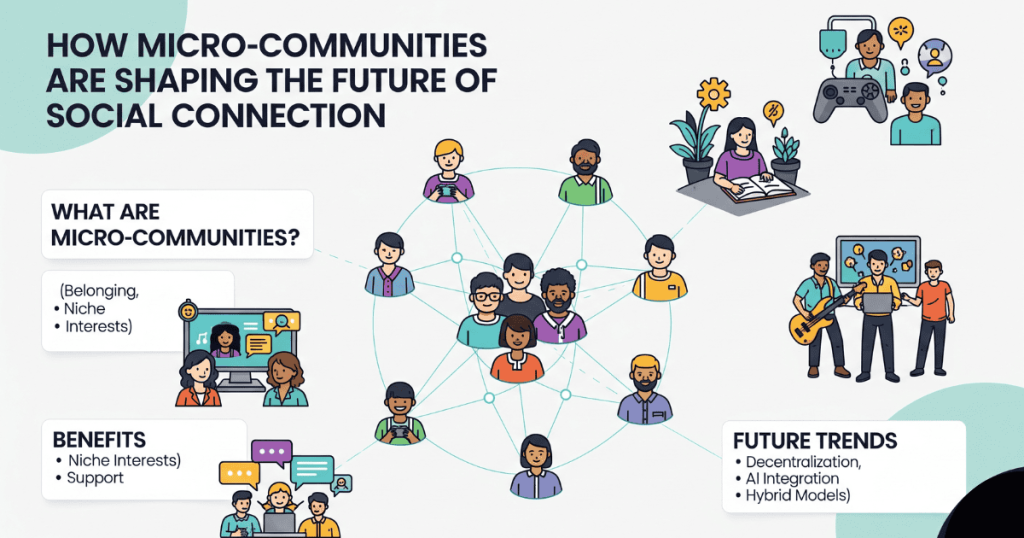Social media giants promised to bring the world closer together, but many users report feeling more isolated than ever. The endless scroll of curated content and algorithmic feeds has left people craving authentic, meaningful interactions. Enter micro-communities—intimate digital spaces where genuine connections flourish and members find their tribe.
These small community networks represent a fundamental shift in how we approach online social interaction. Rather than broadcasting to massive audiences, people are gravitating toward niche online communities where they can engage deeply with like-minded individuals. From Discord servers dedicated to specific hobbies to private Facebook groups for local entrepreneurs, micro-communities are redefining what it means to be socially connected.
The future of social connection isn’t about reaching more people—it’s about reaching the right people. As we explore how building micro-communities is transforming digital relationships, we’ll uncover why smaller, more focused groups are becoming the cornerstone of meaningful online engagement and what this means for how we connect moving forward.

The Rise of Micro-Communities in Digital Spaces
The concept of micro-communities isn’t entirely new, but their digital evolution has accelerated dramatically. These intimate gatherings typically consist of 50 to 500 active members who share specific interests, goals, or experiences. Unlike traditional social media platforms, where users compete for attention in crowded feeds, micro-communities create space for every voice to be heard.
What makes these spaces particularly powerful is their focus on quality over quantity. Members join not to accumulate followers or likes, but to engage in substantive conversations with people who understand their passions and challenges. This approach to community participation emphasizes depth of connection rather than breadth of reach.
Digital community growth within these smaller networks happens organically. New members typically arrive through personal recommendations rather than algorithmic suggestions, creating a natural filter that ensures cultural fit. This peer-to-peer engagement model fosters trust and authenticity that’s often missing from larger platforms.
The platforms hosting these communities range from specialized apps like Circle and Geneva to familiar tools repurposed for intimate connection. Slack workspaces transform into creative collectives, WhatsApp groups become support networks, and Reddit communities spawn smaller, invite-only offshoots.
Dig Deeper: Micro-Communities: The Power of Sub-Group Architecture in Scaling Intimate Connections
Why Smaller Networks Create Stronger Bonds
The psychology behind micro-communities reveals why they’re so effective at fostering genuine relationships. Dunbar’s number, which suggests humans can maintain stable relationships with roughly 150 people, provides insight into why smaller groups feel more manageable and meaningful to participants.
Community bonding strategies work more effectively when applied to smaller groups. Members can remember each other’s names, follow ongoing conversations, and develop inside jokes and shared references. This familiarity breeds comfort, encouraging people to share more authentically and support each other more meaningfully.
Social network trends indicate that users are experiencing “platform fatigue” from trying to maintain a presence across multiple large networks. Micro-communities offer relief by providing a single, focused space where members can invest their social energy more efficiently. Instead of spreading themselves thin across various platforms, users can dive deep into communities that truly matter to them.
The intimacy of these spaces also enables more nuanced community engagement trends. Members feel comfortable sharing works-in-progress, asking for help, and celebrating small wins. The reduced noise means important messages don’t get lost, and the smaller scale makes it feasible for community leaders to know their members personally.
Trust develops faster in these environments because actions have clearer consequences. Bad behavior is immediately visible to the entire community, while positive contributions are recognized and appreciated. This accountability creates a self-regulating environment where members naturally maintain high standards of interaction.
Technology Enabling Micro-Community Growth

The tools powering micro-communities have evolved far beyond simple chat rooms. Modern platforms offer sophisticated features that help community leaders create engaging, sustainable spaces for their members.
Discord has emerged as a favorite platform for building micro-communities, offering voice channels, custom roles, and bot integrations that can automate community management tasks. Its gaming origins have been transcended as professional groups, hobby enthusiasts, and learning communities adopt its flexible structure.
Circle and Mighty Networks provide purpose-built solutions for community creators who want more control over their environment. These platforms offer features like course integration, event management, and detailed analytics that help community leaders understand member engagement patterns.
Member retention strategies have become more sophisticated as community leaders learn what keeps people engaged long-term. Successful micro-communities often implement onboarding sequences that help new members find their place, regular programming that gives people reasons to return, and recognition systems that celebrate active contributors.
The rise of community management tools has also democratized the ability to create and maintain these spaces. Automated welcome messages, scheduled content, and engagement tracking help even part-time community leaders maintain vibrant, active groups.
The Business Impact of Micro-Communities
Companies are recognizing micro-communities as powerful tools for customer engagement, product development, and brand loyalty. Rather than trying to build massive followings, smart brands are creating intimate spaces where they can have deeper conversations with their most engaged customers.
Product companies use micro-communities for beta testing and feedback collection. A small group of passionate users can provide more valuable insights than thousands of casual customers. These communities become innovation labs where brands and customers collaborate on improvements and new features.
Service-based businesses leverage micro-communities to deliver ongoing value between transactions. A fitness coach might maintain a small community of clients who support each other between sessions, or a business consultant might create a peer group for their former clients to continue networking and learning together.
The economics of micro-communities often prove more sustainable than trying to maintain engagement across large audiences. It’s easier to keep 100 highly engaged members happy than to consistently create content that resonates with 10,000 diverse followers. This efficiency allows creators and businesses to focus their resources more effectively.
Monetization strategies within micro-communities tend to be more direct and sustainable. Members who feel genuinely valued are more likely to pay for premium access, exclusive content, or additional services. The trust built through consistent, quality interactions translates into stronger business relationships.
Building and Sustaining Micro-Communities

Creating a successful micro-community requires intentional planning and consistent nurturing. The most thriving communities start with a clear purpose that resonates with their intended members. This focus helps attract the right people and gives everyone a shared understanding of what the community is trying to achieve.
Effective community leaders act more like facilitators than authorities. They ask good questions, highlight interesting contributions from members, and create opportunities for others to shine. The goal is to make the community valuable for members rather than just promotional for the leader.
Establishing community guidelines early helps set expectations for interaction quality. The best guidelines focus on the positive behaviors the community wants to encourage rather than just listing prohibited activities. Clear communication about expectations helps members self-regulate and maintains the culture as the community grows.
Regular programming gives communities rhythm and gives members reasons to return consistently. This might include weekly discussion topics, monthly challenges, guest expert sessions, or seasonal events. The key is creating predictable value that members can count on.
Community engagement strategies that work in micro-communities often involve creating opportunities for member-to-member connection. Peer introductions, collaboration projects, and small group discussions help strengthen the network effect that makes communities valuable beyond just the content shared.
Challenges Facing Micro-Communities
Despite their advantages, micro-communities face unique challenges that leaders must navigate carefully. Growth management becomes critical—communities can lose their intimate feel if they expand too quickly or without proper onboarding systems.
Platform dependency creates vulnerability for community leaders who don’t own their gathering spaces. Changes to platform policies, pricing, or features can disrupt established communities. Some leaders are exploring options like building their own platforms or maintaining a presence across multiple platforms to reduce this risk.
Maintaining engagement over time requires constant creativity and attention. The novelty that attracts initial members can wear off, and community leaders must continually find new ways to provide value and spark conversations. This ongoing commitment can be exhausting for volunteer community leaders.
Diversity and inclusion can be challenging in micro-communities that form around specific interests or demographics. The very specificity that makes these communities valuable can also create echo chambers if not managed thoughtfully. Intentional efforts to welcome different perspectives while maintaining community focus require a delicate balance.
Monetization pressures can threaten community culture if not handled carefully. Members join for authentic connections, and overly commercial approaches can damage trust. Finding sustainable funding models that don’t compromise community values remains an ongoing challenge for many leaders.
The Future Landscape of Social Connection
The trajectory toward smaller, more intimate online communities appears likely to accelerate as people become increasingly selective about where they invest their social energy. The future of social connection will likely involve curating a small portfolio of meaningful communities rather than trying to maintain a broad social media presence.
Artificial intelligence may play a growing role in helping people find the right micro-communities for their interests and facilitating better matches between potential members and existing groups. However, the human element of community leadership and member interaction will remain irreplaceable.
Integration between micro-communities and larger platforms may evolve, allowing small groups to maintain their intimacy while still having access to broader networks when needed. This hybrid approach could offer the best of both worlds—deep connections within small groups and wider reach when appropriate.
The tools for building micro-communities will likely become more sophisticated and accessible, making it easier for anyone to create and maintain a thriving small community. As these barriers to entry decrease, we can expect to see even more specialized and niche communities emerge.
Corporate adoption of micro-community strategies will probably expand as companies recognize the superior engagement and loyalty these approaches can generate compared to traditional social media marketing. This shift may drive innovation in community platform features and business models.
Dig Deeper: Micro-Communities: The Power of Small, Focused Groups Within Larger Networks
Embracing the Micro-Community Movement
Micro-communities represent more than just another social media trend—they signal a fundamental shift toward more intentional, meaningful online relationships. As people grow weary of performative social media and algorithmic feeds, these intimate digital spaces offer refuge and authentic connection.
The future belongs to communities that prioritize depth over reach, quality over quantity, and genuine relationships over superficial engagement. Whether you’re looking to connect with others who share your passions or hoping to build a business around community, micro-communities offer a proven path to more meaningful social connections.
Consider exploring existing micro-communities in your areas of interest, or think about what type of intimate community you might want to create. The tools and knowledge needed to build thriving small communities are more accessible than ever, and the hunger for authentic connection continues to grow.
The social media landscape of tomorrow won’t be dominated by whoever can shout the loudest to the biggest audience. Instead, it will be shaped by those who can create spaces where people feel truly seen, heard, and valued. Micro-communities are leading this transformation, one genuine conversation at a time.





